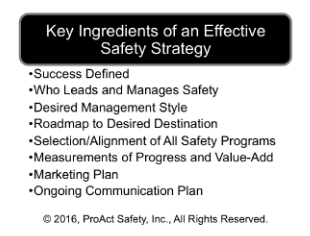Occupational Health & Safety - January 2016
By: Shawn M. Galloway
Printable Version
How effective is your safety strategy? Does it have the key ingredients or is it missing something important?
In 2005 my second daughter was born and, shortly afterwards, baptized. On that day, my wife's parents were in town to celebrate the occasion. Prior to the service, my mother in-law labored intensively in the kitchen preparing a wonderful meal for later that afternoon. When the time came for us to find ourselves around the table appreciating her hard work, including her homemade chicken salad, I couldn't help but notice a strange look on her face.
Several minutes after everything had been served, she started laughing. As we all inquired into what appeared to be an inside joke, she let us in: she had forgotten the chicken. Missing a key ingredient is easy to overlook in something as simple as chicken salad or as complex as a corporate or site-specific safety strategy.
Many companies have goals, programs and well-defined tactics, but only the best have an effective safety strategy (see figure: Key Ingredients of an Effective Safety Strategy). Regardless of business focus, a strategy is a framework of choices, tradeoffs, and small bets an organization makes to determine how to capture and deliver value. A real strategy defines how to win, not how to fail less. To create a comprehensive safety strategy, several key ingredients are necessary.

Figure: Key Ingredients of an Effective Safety Strategy
Success Defined - It must be clear who the customer is and what success looks like when it is achieved. This is more than results, for the challenge that follows great results is in knowing precisely how they were accomplished. It must be clear what the destination will look like; otherwise everyone will be left to to individually define what path they take and what it looks like when they arrive. What would be common (i.e., beliefs, behaviors, competencies, knowledge, experiences, language, stories) when great results are sustainable?
Who Leads and Manages Safety - One cannot delegate a core value. If the strategy includes driving safety from a perceived priority to value, it must be defined what the specific injury-prevention and culture-enhancing roles, responsibilities and observable results are. Do the leaders lead and manage safety or is it managed by the safety professional?
Desired Management Style - What is needed from those in leadership positions? Does drastic change need to occur rapidly or is the goal employee ownership, involvement and collaboration? What style of management and leadership is needed? A strategy to meet aggressive regulatory compliance is much different than one focusing on a culture of excellence. Styles will evolve but should be situational for what is needed at the moment in time.
Roadmap to Desired Destination - If people cannot see where the organization is going, what it will look like when they get there and how to decipher where they are on the journey, expect confusion and minimal discretionary effort.
Selection/Alignment of All Safety Programs - Effective strategy requires there to be fit and alignment among the many activities, goals and plans of the organization. Safety should never compete with production; it should add value to it and those impacted by the efforts. What programs or activities do you need to start, modify or stop? What creates the perception of complimentary versus conflicting? Does the safety strategy support or hinder the overall business strategy?
Measurements of Progress and Value-Add - Visible progress towards a goal is a known effective motivator, so ensure your strategy provides it. Further, it must continue to answer the "what's in it for me" question that never goes away. Those impacted by the strategy should be able to name two or three wins from the strategy and how it is specifically benefiting them or their roles personally.
Marketing Plan - For discretionary effort, you must compete for attention; thus, you need a marketing plan. How will you brand your strategy? How will you position that brand? How will you capture the voice of the customer to ensure value-add and how will you reinforce the decision to buy-in afterward?
Ongoing Communication Plan - Communication is a process, not an event; and it is known that one of the major reasons for resistance to change is people don't understand the reason for the change. Organizations that tend to outperform others do so with highly engaged employees who feel like they are in the know regarding the company strategy and their evolving role within it.
A great strategy charts the course and explains where the organization is going, where they are currently against the plan, what it will look like when they get there, what data supported the decisions that were made and what measurements will provide timely feedback to continue the path, course-correct and continuously improve. As you work to develop or enhance your safety excellence strategy, make sure it includes these proven, vital ingredients.

Shawn M. Galloway is the CEO of ProAct Safety and an advisor to leading organizations across all major industries. With over twenty years of experience in safety systems, strategy, culture, leadership, and employee engagement, he is a trusted advisor, keynote speaker, and expert witness.
He is the author of several bestselling books and has multiple regular columns in leading magazines, with over 400 articles and 100 videos to his credit. He also created the first safety podcast, Safety Culture Excellence, with over 800 episodes. Shawn has received numerous prestigious accolades and has been featured in Power 101 Leaders of the EHS World, Top 50 People Who Most Influenced EHS, Top 40 Rising Stars, Top 11 Health and Safety Influencers, and Top 10 Speakers.
He serves on the Harvard Business Review Advisory Council and the Fast Company Executive Board. He has appeared as a guest on Bloomberg, Fox News, The Daily Mail, Dubai One, U.S. News & World Report, Sirius Business Radio, Wharton Business Daily, and leading safety magazines and podcasts, reinforcing his status as an authority in the field of safety excellence.
For more information, call +1.936.273.8700 or email info@ProActSafety.com.
